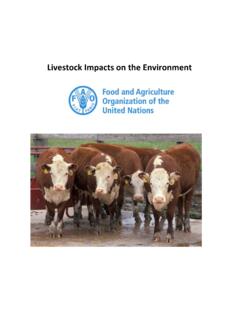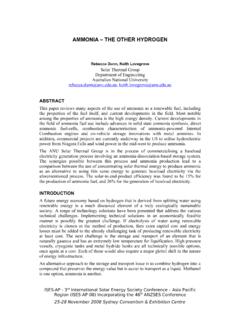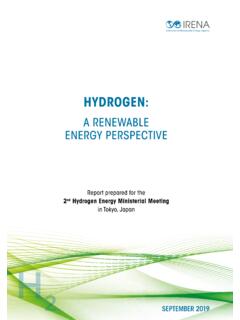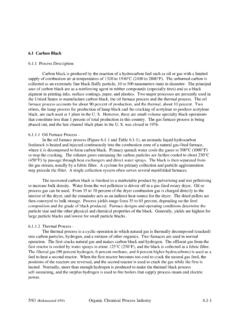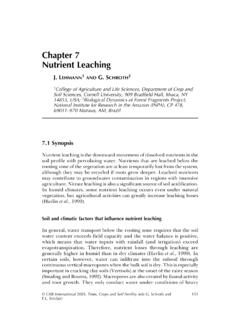Transcription of BIOMASS GASIFICATION - nariphaltan.org
1 1(Published as a Chapter (No. 4) in book Alternative Energy in Agriculture , Vol. II, Ed. D. Yogi Goswami, CRC Press, 1986, pgs. 83-102.). (Author's comments: Since publication of this chapter lot of work in GASIFICATION has taken place in our lab. Please see the history of GASIFICATION research at NARI ). BIOMASS GASIFICATION By Anil K. Rajvanshi Director, Nimbkar Agricultural Research Institute,PHALTAN-415523, Maharashtra, India I INTRODUCTION Modern agriculture is an extremely energy intensive process. However high agricultural productivities and subsequently the growth of green revolution has been made possible only by large amount of energy inputs, especially those from fossil fuels1. With recent price rise and scarcity of these fuels there has been a trend towards use of alternative energy sources like solar, wind, geothermal However these energy resources have not been able to provide an economically viable solution for agricultural applications3.
2 One BIOMASS energy based system, which has been proven reliable and had been extensively used for transportation and on farm systems during World War II is wood or BIOMASS gasification4. BIOMASS GASIFICATION means incomplete combustion of BIOMASS resulting in production of combustible gases consisting of Carbon monoxide (CO), Hydrogen (H2) and traces of Methane (CH4). This mixture is called producer gas. Producer gas can be used to run internal combustion engines (both compression and spark ignition), can be used as substitute for furnace oil in direct heat applications and can be used to produce, in an economically viable way, methanol an extremely attractive chemical which is useful both as fuel for heat engines as well as chemical feedstock for industries5. Since any BIOMASS material can undergo GASIFICATION , this process is much more attractive than ethanol production or biogas where only selected BIOMASS materials can produce the fuel.
3 Besides, there is a problem that solid wastes (available on the farm) are seldom in a form that can be readily utilized economically Wood wastes can be used in hog fuel boiler but the equipment is expensive and energy recovery is low6. As a result it is often advantageous to convert this waste into more readily usable fuel from like producer gas. Hence the attractiveness of GASIFICATION . However under present conditions, economic factors seem to provide the strongest argument of considering gasification7, 8. In many situations where the price of petroleum fuels is high or where supplies are unreliable the BIOMASS GASIFICATION can provide an economically viable system provided the suitable BIOMASS feedstock is easily available (as is indeed the case in agricultural systems). NARI. 2014 2II HISTORICAL BACKGROUND The process of GASIFICATION to produce combustible from organic feeds was used in blast furnaces over 180 years ago.
4 The possibility of using this gas for heating and power generation was soon realized and there emerged in Europe producer gas systems, which used charcoal and peat as feed material. At the turn of the century petroleum gained wider use as a fuel, but during both world wars and particularly World War II, shortage in petroleum supplies led to widespread re-introduction of GASIFICATION . By 1945 the gas was being used to power trucks, buses and agricultural and industrial machines. It is estimated that there were close to 9000,000. Vehicles running on producer gas all over the world9 . After World War II the lack of strategic impetus and the availability of cheap fossil fuels led to general decline in the producer gas industry. However Sweden continued to work on producer gas technology and the work was accelerated after 1956 Suez Canal crisis.
5 A decision was then made to include gasifiers in Swedish strategic emergency plans. Research into suitable designs of wood gasifiers, essentially for transport use, was carried out at the National Swedish Institute for Agricultural Machinery Testing and is still in progress10 . The contemporary interest in small scale gasifier R&D, for most part dates from 1973 oil crisis. The research in this area is reviewed by Goss11. The manufacturing also took off with increased interest shown in GASIFICATION technology. At present there are about 64 GASIFICATION equipment manufacturers all over the world11,36. The present status of GASIFICATION technology and R&D activities will be discussed in chapter VII. III THEORY OF GASIFICATION The production of generator gas (producer gas) called GASIFICATION , is partial combustion of solid fuel ( BIOMASS ) and takes place at temperatures of about 10000C.
6 The reactor is called a gasifier. The combustion products from complete combustion of BIOMASS generally contain nitrogen, water vapor, carbon dioxide and surplus of oxygen. However in GASIFICATION where there is a surplus of solid fuel (incomplete combustion) the products of combustion are (Figure 1) combustible gases like Carbon monoxide (CO), Hydrogen (H2) and traces of Methane and nonuseful products like tar and dust. The production of these gases is by reaction of water vapor and carbon dioxide through a glowing layer of charcoal. Thus the key to gasifier design is to create conditions such that a) BIOMASS is reduced to charcoal and, b) charcoal is converted at suitable temperature to produce CO and H2. A. Types of Gasifiers Since there is an interaction of air or oxygen and BIOMASS in the gasifier, they are classified according to the way air or oxygen is introduced in it.
7 There are three types of gasifiers (Figure 2); Downdraft, Updraft and Crossdraft. And as the classification implies updraft gasifier has air passing through the BIOMASS from bottom NARI. 2014 3and the combustible gases come out from the top of the gasifier. Similarly in the downdraft gasifier the air is passed from the tuyers in the downdraft direction. With slight variation almost all the gasifiers fall in the above categories. The choice of one type of gasifier over other is dictated by the fuel, its final available form, its size, moisture content and ash content12. Table 1 lists therefore, the advantages and disadvantages generally found for various classes of gasifiers. Table 1. Advantages and Disadvantages of various Gasifiers Sr. No. Gasifier Type Advantage Disadvantages 1. Updraft - Small pressure drop - good thermal efficiency - little tendency towards slag formation - Great sensitivity to tar and moisture and moisture content of fuel - relatively long time required for start up of IC engine - poor reaction capability with heavy gas load 2.
8 Downdraft - Flexible adaptation of gas production to load - low sensitivity to charcoal dust and tar content of fuel - Design tends to be tall - not feasible for very small particle size of fuel 3. Crossdraft - Short design height - very fast response time to load - flexible gas production - Very high sensitivity to slag formation - high pressure drop NARI. 2014 4B. Process Zones Four distinct processes take place in a gasifier as the fuel makes its way to GASIFICATION . They are : a) Drying of fuel b) Pyrolysis a process in which tar and other volatiles are driven off c) Combustion d) Reduction Though there is a considerable overlap of the processes, each can be assumed to occupy a separate zone where fundamentally different chemical and thermal reactions take place. Figure 3 shows schematically an updraft gasifier with different zones and their respective temperatures.
9 Figure 4 and 5 show these regions for downdraft and crossdraft gasifiers respectively. In the downdraft gasifiers there are two types : a) Single throat and, b) Double throat (Figure 6). NARI. 2014 5 Single throat gasifiers are mainly used for stationary applications whereas double throat are for varying loads as well as automotive purposes. C. Reaction Chemistry The following major reactions take place in combustion and reduction zone12. 1. Combustion zone The combustible substance of a solid fuel is usually composed of elements carbon, hydrogen and oxygen. In complete combustion carbon dioxide is obtained from carbon in fuel and water is obtained from the hydrogen, usually as steam. The combustion reaction is exothermic and yields a theoretical oxidation temperature of 14500C14. The main reactions, therefore, are: C + O2 = CO2 (+ 393 MJ/kg mole) (1) 2H2 + O2 = 2H2 O (- 242 MJ/kg mole) (2) 2.
10 Reaction zone The products of partial combustion (water, carbon dioxide and uncombusted partially cracked pyrolysis products) now pass through a red-hot charcoal bed where the following reduction reactions take place12. C + CO2 = 2CO (- MJ/kg mole) (3) C + H2O = CO + H2 (- MJ/kg mole) (4) CO + H2O = CO + H2 (+ 42 MJ/kg mole) (5) C + 2H2 = CH4 (+ 75 MJ/kg mole) (6) CO2 + H2 = CO + H2O (- MJ/kg mole) (7) Reactions (3) and (4) are main reduction reactions and being endothermic have the capability of reducing gas temperature. Consequently the temperatures in the reduction zone are normally 800-10000C. Lower the reduction zone temperature (~ 700-8000C), lower is the calorific value of gas.



